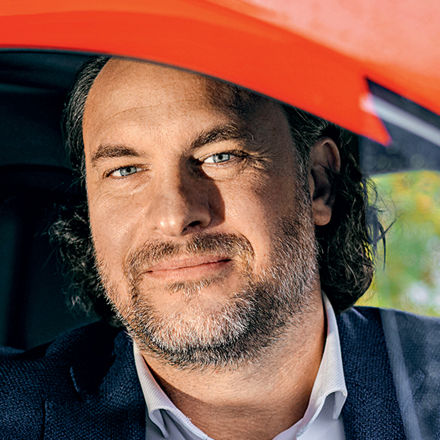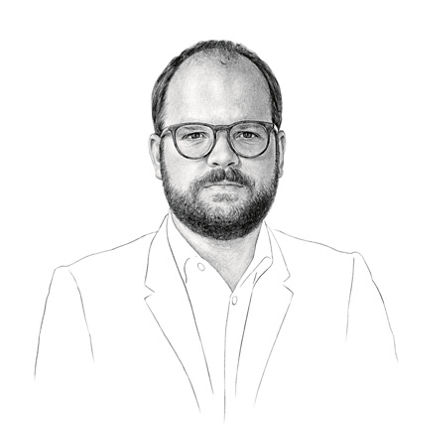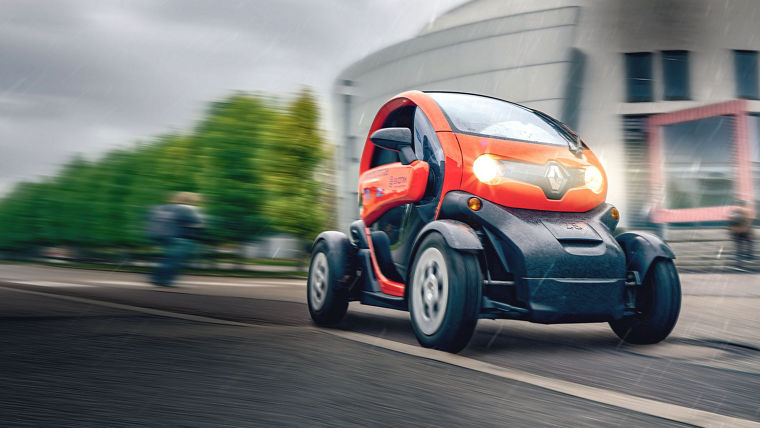Amidget drives in circles through the drizzle in Garching near Munich: In a research project, an electric Renault Twizy microcar circles around buildings at the Technical University of Munich (TUM). The car isn’t road-ready yet. Its transmission is only a prototype. Scientists at TUM have installed plastic gears in the transmission on a trial basis, replacing the steel components that are otherwise employed. This is made possible by a special material from Evonik.
This research project funded by Germany’s Federal Ministry for Economic Affairs and Climate Action (BMWK) aims to develop and evaluate a lightweight transmission that uses high-performance plastic gears. The transmission is intended for small urban electric vehicles. In addition to TUM and Evonik, the Werner Bauser company, a medium-size specialist in the precise manufacture of plastic gears, is also involved. The three of them want to turn the plastic into an alternative material for small electric vehicle transmissions. They want to prove as practically as possible that it can withstand the forces within the transmission over a long period and at the same time make driving more economical and quiet. The demonstration vehicle is a Twizy that has slightly less than 13 kilowatts of peak power and a top speed of 80 km/h.
“The performance class of these electric microcars makes them ideal for plastic-based transmissions. Both - microcars and plastic components in the drivetrain - can play a key role if we want livable cities with sustainable mobility in the future,” explains Dr. Karsten Stahl, Professor of Machine Elements at TUM and Head of the Gear Research Center (FZG).
Midgets on the move
Four-wheeled one- and two-seaters with an engine output of up to 15 kilowatts, such as the Renault Twizy, belong to the EU vehicle category L7e. Known as microcars, these vehicles are designed for urban use. A Mc¬Kinsey study from 2022 predicts that “mini-mobility” with vehicles in the niche between e-bikes and cars will be “the next big thing.” The global market could grow to around US$100 billion by 2030. This isn’t the first time that microcars have been predicted to make a major breakthrough. But the reality is still quite different. In Germany, a mere 1,487 microcars were registered last year, compared to a total of almost 2.9 million new registrations. This represents a share of just 0.05 percent. However, national climate targets and municipal initiatives for traffic-calmed cities could act as a turbocharger for the electric midgets. In 2023, a group of European manufacturers joined forces in the Microcar Coalition to proactively campaign for state funding and privileges in cities. In the meantime, brands such as Opel and Citroën as well as some startups and Chinese manufacturers have put microcars on the road. Although Renault discontinued production of the Twizy last year after a good ten years and around 33,000 units sold worldwide, it is entering the car-sharing business with the vehicle’s successor, the Duo.
A blind spot of science
The FZG has been researching gears for more than 70 years. Many internationally valid guidelines and industry standards originated here. Almost 100 test benches run in parallel in the institute’s rooms—often at night, when they don’t disturb anybody. From individual gear wheels to complete turbofan gearboxes for aircraft turbines, pretty much everything is put to the test here. Research contracts also come from car manufacturers and suppliers who want to get the last bit of efficiency out of their gearboxes. “It’s the epitome of mechanical engineering,” says Stahl about this work and adds, “For decades, many scientists underestimated the trend towards plastic gears.”
Plastic gears have long been used everywhere and are usually more prevalent than gears made of other materials—even in cars: The fuel pump, oil pump, windshield wipers, power windows, seat adjustment, ventilation, and much more are set in motion by plastic parts. This isn’t surprising, because gear wheels made of plastic are not only less expensive to manufacture, they also save weight and waste less energy because less mass is set in motion and the surfaces slide against one another very well. They also absorb vibrations, and that makes them particularly quiet. Only in the drivetrains of cars, where high torques, chemically aggressive lubricants, and high temperatures prevail, is steel still the material of choice. But even this bastion is crumbling.

»For decades, many scientists have underestimated the trend towards plastic gears«
KARSTEN STAHL Professor of Machine Elements at the Technical University of Munich
Transmissions as a stumbling block
Mercedes-Benz has been using plastic gears in mass-balance transmissions in its series-production models since 2022. Such transmissions compensate for engine vibrations and ensure smoother running. Because the gears come into contact with hot engine oil, they always used to be made of steel. At Mercedes, they are now made of Vestakeep® 5000G, a heat-stable high-performance polymer from Evonik, which makes the entire assembly more efficient and also reduces vibration. The research project at the FZG is now taking this material one step further. “This is the first time we are using plastic directly in the drive system for power transmission,” says Professor Stahl. “That’s totally new.”
Stahl quotes from a paper by the Wissenschaftliche Gesellschaft für Produktentwicklung (Scientific Society for Product Development), according to which constant technical evolution has made transmission technology around four to five percent more compact, more efficient, and quieter every year. It’s a kind of Moore’s law for machine parts. Just as the processor density of microchips in semiconductor technology has regularly increased over the decades, the performance of transmissions is also continuously improving. “High-performance polymers enable us to continue this development,” says Stahl.

The Twizy’s transmission was deliberately chosen as a simple demonstration object: The two-stage transmission in the electric microcar cannot be shifted and consists of just four cogwheels. “The aim was to use plastic gears to create a transmission stage in a series-production vehicle but otherwise change as little as possible,” explains Stahl. The two gear wheels of the first stage were replaced. Those in the second stage, where the torque is greater, are still made of steel. Another concession is that in order to distribute the force over a larger area, the plastic gears are around twice as wide as their metal counterparts. To achieve this, the housing was widened by two centimeters.
Following extensive computer simulations, the FZG built three prototypes of such modified transmissions. While one runs in the vehicle, two others are braced against each other on an especially developed test bench. “This allows us to run the transmissions against each other with a defined torque and examine them in isolation from external factors,” explains Stefan Reitschuster, while he and his colleague Nicolai Sprogies use their muscles to preset the torque. Reitschuster and Sprogies are two of several TUM doctoral candidates working on the project.
The tests have been running for several months. Speed, torque, and oil temperature are varied externally according to standardized test cycles in order to simulate tens of thousands of kilometers of real everyday road use in a short space of time. A host of sensors monitor the whole thing. Twenty-eight probes document the temperature alone, and the measurement of vibrations and noise will be the subject of a separate doctoral thesis. One finding is that the new gears show no significant signs of fatigue after the first 10,000 kilometers of driving.
This surprises no one at Evonik in Darmstadt. “Our Vestakeep® 5000G is pretty much the best-performing polymer on the market at the moment,” says Philipp Kilian, who heads the Tribology department in the High Performance Polymers business line at Evonik. The work at this department focuses on everything to do with wear, friction, and lubrication, he says. The specialty chemicals company not only supplied the material for the gear wheel, but also the material data for the simulation.

Tough stuff
In addition to high-performance polymers, Evonik also produces high-performance lubricants. Evonik operates a test laboratory for both in Darmstadt. As in Munich, machine parts are maltreated behind soundproof doors in the service of research. In cooperation with the gear manufacturer Werner Bauser, Evonik has developed a test bench specifically for plastic gears. From the first “pits” in the side of a tooth to the catastrophic “tooth root breakage” - the total loss of a transmission - Evonik can use this test bench to generate realistic wear and analyze it under its own scanning electron microscopes, for example.
The brand name Vestakeep® is used to designate polyether ether ketone, or PEEK for short. For the past several years, this class of plastics has been replacing more and more steel components in various sectors. The material is extremely resistant to abrasion and many aggressive chemicals. In addition, the material can permanently withstand temperatures of around 250 degrees Celsius and even endure up to 300 degrees Celsius for short periods. “It is also inherently flame-retardant, highly pure, and very dimensionally stable. That’s why the semiconductor industry, for example, uses high-precision tools made of PEEK to process sensitive wafers,” explains Sandra Kao, who is responsible for Vestakeep® marketing worldwide for Evonik from Taipei (Taiwan). “Some car manufacturers are also using PEEK to develop safe new batteries, busbars, and other components for the ever-increasing currents in next-generation electric cars.”
Vestakeep® 5000G, which Mercedes-Benz and the FZG use, is Evonik’s top product when it comes to PEEK. The number 5000 refers to the highest molecular weight currently available, i.e. the particularly long molecular chain. The G stands for the delivery form as granules. For the tests at the FZG, Werner Bauser manufactured around a dozen gears from this product. The family-run company from Wehingen on the edge of the Swabian Alb has been exclusively manufacturing plastic screws and gears since it was founded 60 years ago. They are used in drills and garage door drives, for example. Recently the trends towards height-adjustable desks and e-bikes have once again boosted demand, says Bauser Sales Director Thomas Simon.

»We can mold plastic into very complex shapes, which is not possible with steel«
THOMAS SIMON Head of Sales at the gear wheel manufacturer Werner Bauser
Injection molding as the crucial factor
The people at Werner Bauser are particularly proud of their expertise in transmission design and their precision in injection molding. “Not everyone can produce large machine components with tolerances in the micrometer range,” says Simon. But that is precisely what is needed. Injection molding is what makes plastic gears inexpensive and economical to produce. Steel gears are milled individually, which is laborious and creates waste. Injection molding machines, on the other hand, spew finished gears onto the assembly line - up to 750,000 a day at Bauser. “We can also produce very complex shapes from a mix of very different materials, which is not possible with steel,” says Simon. 3D printing is likely to open up even more possibilities. Researchers at the FZG are already dreaming of plastic gears with integrated sensors and coolant channels, among other things.
However, the most important argument in favor of plastic is neither the lower costs nor the design freedom - not even the weight savings, says Stahl. “All gear experts are currently working on improving the acoustic behavior of transmissions,” he reveals.
In electrically powered cars, the transmission is the number one source of noise. When there is no rumbling combustion engine, other noises are all the more noticeable. The industry calls this phenomenon “noise, vibration, harshness,” or NVH for short. That’s because it’s not just about noise, but also about vibration and harshness. The latter term comes from psychoacoustics and describes frequency ranges that are consciously and unconsciously perceived as unpleasant. It is known that the viscoelastic behavior of plastic gears enables them to absorb more of these frequencies. As a result, the gears can significantly improve NVH values.

»Steel out, plastic in - unfortunately it's almost never that simple.«
PHILIPP KILIAN HEAD OF THE TRIBOLOGY DEPARTMENT IN THE EVONIK HIGH PERFORMANCE POLYMERS BUSINESS LINE
Nevertheless, Bauser, Evonik, and TUM are familiar with the old saying among mechanical engineers: “People who know plastic choose steel.” Advanced materials science has produced many plastics for highly efficient and intelligent applications, but the use of plastics still has its own challenges, says Kilian. “Just replace steel with plastic? Unfortunately, it’s almost never that simple.” That’s because plastic is more complex than steel. Plastic reacts more dynamically, more flexibly, and is more temperature-dependent than steel. Added to this is the wider range of plastics, which react very differently depending on their molecular structure, manufacturing process, and additives. Accordingly, a lot of research still needs to be done.
The successor of the research project in Munich is ready for launch. In this new project, TUM, Evonik, and Bauser have brought other automotive suppliers and even a car manufacturer on board to develop a plastic transmission from scratch. The arrangement and shape of the teeth, the transmission ratio, the housing - everything has to be tailored precisely to the strengths of the material. “The steel gears have a 100-year head start in automobiles,” says Professor Stahl. “We are still at the beginning with this plastic, but that’s what makes it so exciting.”

"Making the most of your talents"
Professor Dr. Karl Kuhmann is Head of Technology and Process Development for Plastics Processing of High Performance Polymers at Evonik and has been teaching plastics technology at Friedrich-Alexander-Universität Erlangen-Nürnberg for over 20 years.
Professor Kuhmann, you are currently giving your annual introduction to multi-component plastic injection molding for students of mechanical engineering and materials science. What do you learn there?
Students are usually amazed at what can be achieved with plastics using injection molding technology today: how wide the range of applications is, for example, and that even complex multifunctional components can be produced fully automatically from different materials.
High-performance plastics are increasingly replacing steel, especially in automotive engineering. Do you still have to overcome prejudices against plastics?
The potential is far from exhausted. But it's not about playing one material off against the other. Plastic can do things that steel can't - and vice versa. I see the greatest benefit when we use the advantages of both material groups in a very targeted way and combine them correctly. For example, in hybrid components that make optimum use of the strengths of steel and, in key areas, the strengths of different plastics.
Why does plastic unfold its potential here in particular?
Lightweight construction and efficiency are particularly in demand. And new, exciting possibilities are constantly emerging: in polymer design itself, in new processing technologies and in the plastic-compatible construction of components. 3D printing, for example, offers additional design freedom. And injection molding also allows us to combine different components with different material properties in one component. However, this has not all come out of the blue, but is based on decades of intensive research and development in plastics technology. We can simply leverage more of the potential of plastics if we bring the various disciplines such as plastics technology, metal and gear technology and materials science closer together in order to make the most of the material's talents.




